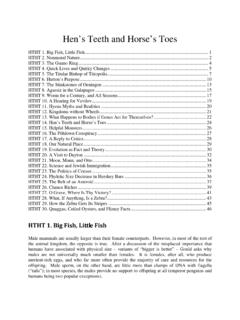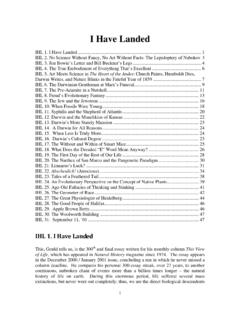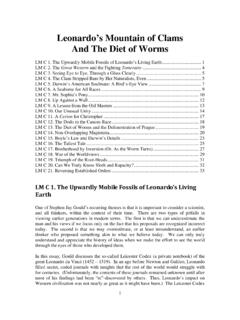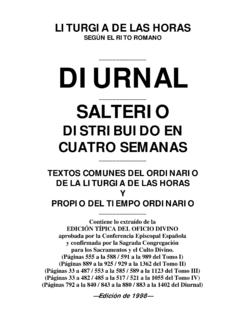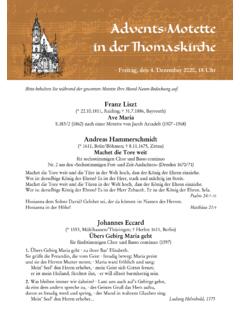Transcription of The Panda’s Thumb
1 1 The Panda s Thumb TPT 1. The Panda s Thumb .. 1 TPT 2. Senseless Signs of History .. 3 TPT 3. Double Trouble .. 3 TPT 4. Natural Selection and the Human Brain: Darwin vs. Wallace .. 5 TPT 5. Darwin s Middle Road .. 8 TPT 6. Death Before Birth, or a Mite s Nunc Dimittis .. 9 TPT 7. Shades of Lamarck .. 11 TPT 8. Caring Groups and Selfish Genes .. 12 TPT 9. A Biological Homage to Mickey Mouse .. 15 TPT 10. Piltdown Revisited .. 15 TPT 11. Our Greatest Evolutionary Step .. 18 TPT 12. In the Midst of Life .. 19 TPT 13. Wide Hats and Narrow Minds .. 20 TPT 14. Women s Brains .. 21 TPT 15. Dr. Down s Syndrome.
2 22 TPT 16. Flaws in the Victorian Veil .. 23 TPT 17. The Episodic Nature of Evolutionary Change .. 24 TPT 18. Return of the Hopeful Monster .. 26 TPT 19. The Great Scablands Debate .. 28 TPT 20. A Quahog is a Quahog .. 29 TPT 21. An Early Start .. 30 TPT 22. Crazy Old Randolph Kirkpatrick .. 32 TPT 23. Bathybius and Eozoon .. 33 TPT 24. Might We Fit Inside a Sponge s Cell .. 35 TPT 25. Were Dinosaurs Dumb? .. 38 TPT 26. The Telltale Wishbone .. 38 TPT 27. Nature s Odd Couples .. 41 TPT 28. Sticking Up for Marsupials .. 42 TPT 29. Our Allotted Lifetimes .. 43 TPT 30. Natural Attraction: Bacteria, the Birds and the Bees.
3 43 TPT 31. Time s Vastness .. 44 TPT 1. The Panda s Thumb This is one of Stephen Jay Gould s most famous essays. It makes the case that biological contrivances, jury-rigged structures made from available parts, provide better evidence that evolution has occurred in natural history than structures that appear optimized for their function, such as wings or eyes. This is not an original argument, Gould notes; it was put forth by Darwin himself. Darwin also coined this use of the term contrivance. In later essays, Gould will refer to this as the principle of imperfection.
4 2 Gould visited the National Zoo in Washington, , shortly after the famous pandas had been presented as a gift from China after President Nixon s visit. He observed that they appeared to be peeling their bamboo (to get at the shoots, the only part they eat) with the help of an opposable Thumb . Being unaware that any members of the carnivore family had opposable thumbs, he looked closer, and counted the digits; including the Thumb , there were six. This was another puzzle, since while some vertebrates were known to have fewer than six digits per limb, none had more [but see ELP 4].
5 He went to the library and found the classic monograph on pandas : The Giant Panda: a morphological study of evolutionary mechanism by D. D. Davis, 1964. Davis, we are told, wrote all about this: the Thumb is in fact an enlarged sesamoid (one of the wrist bones), manipulated by muscles and tendons that serve a different function in other types of bears. If individual organisms were created from scratch (either naturally or divinely), then this unwieldy contrivance would be a very odd way of designing an opposable digit.
6 If, on the other hand, the panda arose via decent with modification (Darwin s phrase) from a bear with more conventional paws, then a structure like the Panda s Thumb makes more sense. It would have to have been formed out of parts that were available. The ancestral bear s first digit the real Thumb was not available due to its earlier specialization for walking. Whether by natural selection, or a Lamarckian need that expresses itself as an inheritable change, or by a God who likes to tinker with established organisms rather than make new ones from scratch, the conclusion is the same: the Panda s Thumb is a contrivance, and therefore evidence that evolution modification of an earlier species to form a new one occurred.
7 These awkward contrivances retain evidence of natural history and provide essential evidence against creation. [An important subtlety of this view is that, if the panda were the only bear or the only carnivore in existence, this clue would not be available. Much of the evidence for evolution comes from examining a species in the context of others, both living and extinct, rather than in isolation.] Both at the beginning and the end of the essay, Gould shows that Darwin understood this point quite clearly. His follow-up to the highly successful Origin of Species (1859) was not The Decent of Man (1871) or another book on a big-picture topic.
8 Instead, it was On the Various Contrivances by which British and Foreign Orchids are Fertilized by Insects (1862). For many years, those in the profession considered this and most of his other books to be evidence that Darwin was a putterer, a not-too-bright dilettante who got lucky once. It took the coming 100th anniversary of the publication of Origin for historians of science to go back and read this apparently tedious book. What they found that it was only nominally about orchids; its true purpose was to provide detailed evidence for evolution, via the argument of contrivances.
9 Individual species of orchids have developed structures that attract individual species of insects; these insects then pollinate only those orchids to which they are matched. The key point, Darwin makes clear, is that all of the unique structures that all of these orchids have developed are all derived from common plant parts leaves, flower pedals, stamens, and so on. They are all contrivances, and thus evidence that each example of this plant family evolved. 3 TPT 2. Senseless Signs of History The previous essay introduced the concept of contrivances.
10 Darwin (and Gould) define contrivances as biological structures formed out of preexisting parts that have been pressed into service, sometimes not very efficiently, to perform a new function. Contrivances are evidence of evolution, albeit not necessarily natural selection. In this essay, we are introduced to the concept of remnants (also Darwin s term), which can also be construed as evidence for evolution. Remnants are structures that served a function in an ancestor, but no function in the modern, descended organism. One of the classic examples is the hipbones of whales: small fragments of bone that are degenerated from the pelvis of a terrestrial ancestor.

